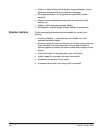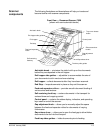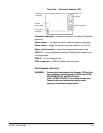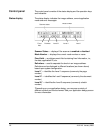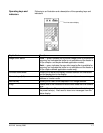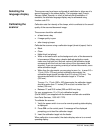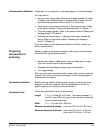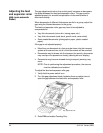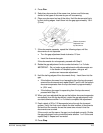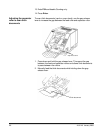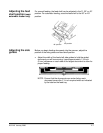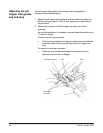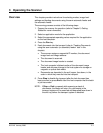
A-61140 January 2000 2-3
Unsuccessful calibration
If calibration is not successful, a message appears in the status display.
You may need to:
• Verify you are using a clean, blank sheet of paper (at least 12 inches
in length) as a calibration target. The paper must be wider than the
documents being scanned and at least 8 1/2 inches long.
• Verify there is not a document already in the document path. (Refer
to the section entitled, “Clearing the document path” in Chapter 7.)
• Clean the imaging guides. (Refer to the section entitled “Cleaning the
imaging guides” in Chapter 5.)
• Calibrate the scanner again. If calibration fails again, change the
lamps. (Refer to the section entitled, “Replacing the exposure
lamps” in Chapter 5.)
If you have done all of the above and calibration still fails, contact your
service representative.
Preparing
documents for
scanning
Before you begin processing documents, make certain the documents
may be fed through the scanner easily:
• Remove any staples, rubber bands, loose mending tape, or paper
clips from the documents to be processed.
• Straighten wrinkled edges and tape any torn documents.
• Trim ragged edges.
When using the semi-automatic feeder, make certain all documents are
of similar size, texture, thickness and weight, and the leading edges of
all documents are aligned.
Document orientation
Before scanning, position all documents the way you want them to be
displayed on the host computer. Feed the documents so the text or
graphic appears to be facing in the same direction.
Document sizes
The following document sizes can be scanned:
Length 2 ½ x 17 inches (64 x 432 mm). Documents between 17
and 30 inches (508 mm) long can be scanned by adjusting
the exit hopper end stops.
Width 2 ½ x 12 inches (64 x 305 mm)
Minimum document thickness: onion skin (0.0015-inch / 0.04 mm)
Maximum document thickness: index card (0.014 inch / 0.36 mm)
index card (0.040 inch / 1.00 mm)



